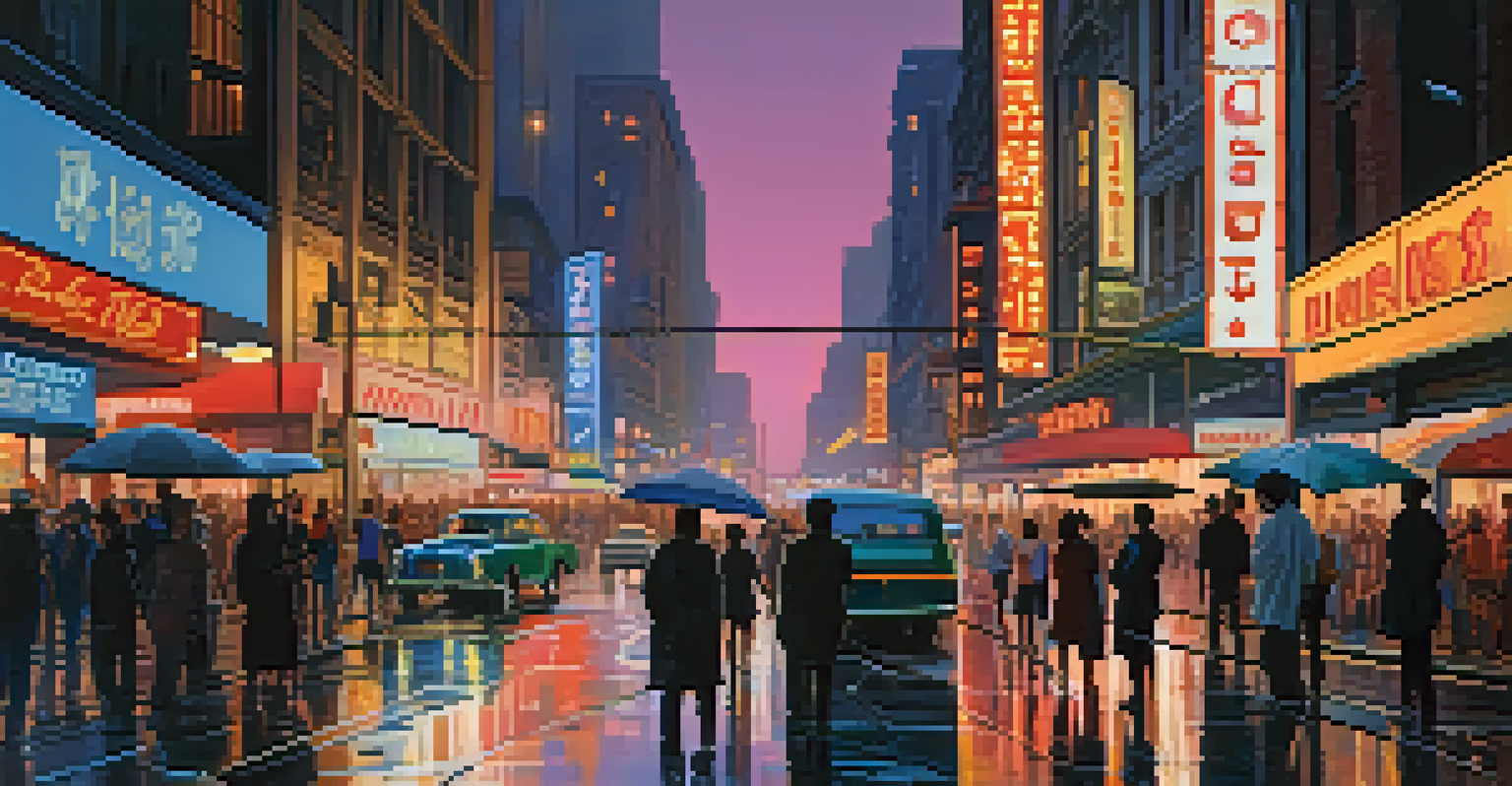Exploring Racial Identity Through Cinematic Storytelling

Understanding Racial Identity in Film
Racial identity is a complex tapestry woven from personal experiences, culture, and societal perceptions. In film, this tapestry becomes a powerful narrative tool, allowing audiences to explore diverse perspectives. Movies often serve as mirrors, reflecting the realities of racial dynamics and identity formation in society.
Cinema is a mirror by which we often see ourselves.
For instance, films like 'Black Panther' not only entertain but also delve into themes of heritage and empowerment within the African diaspora. By showcasing characters who grapple with their racial identities, these films invite viewers to reflect on their own experiences and beliefs. This connection fosters a deeper understanding of the complexities surrounding race.
Through cinematic storytelling, filmmakers can challenge stereotypes and promote empathy. By portraying characters with authenticity and depth, they encourage audiences to engage with narratives that resonate beyond the screen. This engagement can lead to meaningful conversations about race and identity in our everyday lives.
Historical Context of Racial Representation
To appreciate how racial identity is explored in film today, we must consider the historical context of representation. Early cinema often relied on harmful stereotypes, reducing characters to caricatures that reinforced societal prejudices. However, as movements for civil rights gained momentum, filmmakers began to challenge these depictions.

Films from the 1960s and 1970s, such as 'Guess Who's Coming to Dinner,' started to explore interracial relationships and the complexities of race. This shift marked a turning point in how racial identity was portrayed on screen, paving the way for more nuanced storytelling. It reflected a broader societal change, pushing audiences to confront their own biases.
Racial Identity as a Narrative Tool
Films serve as powerful mirrors reflecting diverse racial dynamics, inviting audiences to engage with personal and societal experiences.
Today, we see a continuing evolution in representation, with filmmakers of diverse backgrounds telling their own stories. This shift not only enriches the cinematic landscape but also fosters greater understanding and acceptance among audiences. The historical journey of racial representation in film underscores the importance of diverse voices in shaping narratives.
The Role of Storytelling in Racial Identity
Storytelling is a fundamental aspect of human culture, and its role in exploring racial identity cannot be underestimated. Films have the power to convey experiences that might be unfamiliar to many, breaking down barriers and fostering empathy. Through compelling narratives, filmmakers can illustrate the struggles and triumphs of different racial groups.
The stories we tell are a reflection of who we are as a society.
Consider the impact of films like 'Moonlight,' which beautifully portrays the intersection of race and sexuality. By focusing on a singular, poignant journey, the film invites audiences into the protagonist's world, allowing for a deeper understanding of his racial identity. Such intimate storytelling can resonate with viewers from all backgrounds, urging them to reflect on their perceptions of race.
Moreover, these narratives often challenge the dominant cultural narratives that have historically marginalized certain groups. By amplifying underrepresented voices, filmmakers contribute to a richer, more inclusive storytelling landscape. This shift is crucial for fostering a society that values diversity and promotes understanding.
Cinematic Techniques in Racial Storytelling
Cinematic techniques play a vital role in how racial identity is conveyed on screen. From the use of color and lighting to framing and sound design, each element contributes to the storytelling process. For instance, a film may use contrasting colors to symbolize cultural clashes or employ specific camera angles to highlight a character's isolation.
Take 'The Farewell,' for example. The film utilizes a subtle yet impactful visual palette to convey the nuances of cultural identity within a Chinese-American family. These artistic choices enhance the emotional weight of the story, inviting audiences to engage with the characters' experiences on a deeper level. Such techniques help to communicate complex themes without relying solely on dialogue.
Historical Context Shapes Representation
The evolution of racial representation in film, from harmful stereotypes to nuanced storytelling, reflects broader societal changes and the importance of diverse voices.
Furthermore, sound and music can evoke powerful emotional responses that align with the narrative's themes. A poignant score can amplify moments of tension or joy, reinforcing the characters' struggles and triumphs related to their racial identities. By skillfully combining these elements, filmmakers can create a rich tapestry of storytelling that resonates with viewers.
Audience Reception and Racial Identity
The way audiences receive and interpret films about racial identity can vary widely. Factors such as personal experiences, cultural background, and societal context influence how viewers engage with these narratives. This variability can lead to rich discussions and differing interpretations, highlighting the complexities of racial identity.
For instance, films like 'Crazy Rich Asians' received both praise and criticism, with some viewers celebrating its representation while others felt it fell short in addressing deeper issues of race. Such reactions underscore the importance of dialogue around film and its impact on perceptions of race. Engaging with diverse viewpoints can enrich our understanding of these narratives.
Moreover, social media has amplified these conversations, allowing audiences to share their thoughts and feelings about films in real time. This interaction creates a sense of community and encourages broader discussions about representation and identity. By examining how films resonate with different audiences, we can gain insights into the evolving landscape of racial identity in cinema.
The Impact of Streaming Services on Representation
The rise of streaming services has transformed the cinematic landscape, offering new opportunities for diverse storytelling. Platforms like Netflix and Hulu have made it easier for filmmakers from underrepresented backgrounds to share their stories with a global audience. This shift is crucial for broadening the representation of racial identities in film.
For example, shows like 'Never Have I Ever' showcase the experiences of a South Asian American teenager, highlighting cultural nuances that are often overlooked in mainstream media. By providing a platform for these narratives, streaming services contribute to a richer understanding of racial identities. This accessibility allows viewers to connect with stories that resonate with their own experiences.
Streaming Services Enhance Diversity
The rise of streaming platforms has created opportunities for underrepresented filmmakers to share authentic stories, enriching the portrayal of racial identities.
However, while streaming services have opened doors, there is still work to be done in ensuring diverse representation behind the camera. It’s vital for these platforms to continue supporting creators from various backgrounds. By doing so, they can foster a cinematic environment that authentically reflects the diverse world we live in.
Future Directions for Racial Identity in Film
As we look to the future, the exploration of racial identity in film is poised for continued evolution. With a growing awareness of the importance of representation, filmmakers are increasingly focused on telling authentic stories that resonate with diverse audiences. This trend is encouraging, as it reflects a broader societal push for inclusivity and understanding.
Moreover, emerging technologies, such as virtual reality and interactive storytelling, offer exciting possibilities for how racial identities can be explored. These innovations can create immersive experiences that allow viewers to step into the shoes of characters from different backgrounds, fostering empathy and understanding. The potential for deeper engagement with narratives is limitless.

Ultimately, the future of racial identity in film will depend on the commitment of creators to prioritize authenticity and representation. As new voices emerge and diverse stories are told, we can hope for a cinematic landscape that not only reflects our world but also inspires positive change. The journey of exploring racial identity through film is far from over, and the possibilities ahead are both exciting and hopeful.